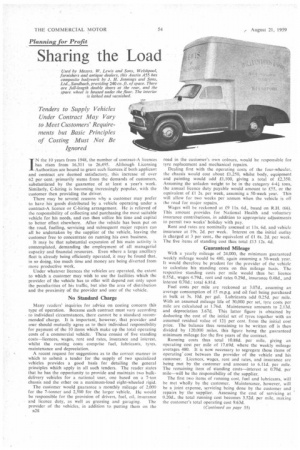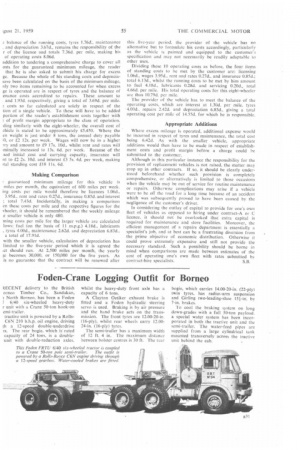Planning for Profit
Page 62

Page 65

If you've noticed an error in this article please click here to report it so we can fix it.
Sharing the Load
Tenders to Supply Vehicles Under Contract May Vary to Meet Customers' Requirements but Basic Principles of Costing Must Not Be Ignored
IN the 10 years from 1948, the number of contract-A licences has risen from 16,311 to 26,495. Although Licensing Authorities are bound to grant such licences if both applicant and contract are deemed satisfactory, this increase of over 62 per cent. primarily sterns from the demands of customers, substantiated by the guarantee of at• least a year's work. Similarly, C-hiring is becoming increasingly popular, with the customer then providing the driver.
There may be several reasons why a customer may prefer to have his goods distributed by a vehicle operating under a contract-A licence or C-hiring arrangement, He is relieved of the responsibility of collecting and purchasing the most suitable vehicle for his needs, and can then utilize his time and capital to better effect elsewhere. After the vehicle has been put on the road, fuelling, servicing and subsequent major repairs can all be undertaken by the supplier of the vehicle, leaving the customer free to concentrate On running his own business.
It may be that substantial expansion of his main activity is contemplated, demanding the employment of all managerial capacity and financial resources. Even where a large ancillary fleet is already being efficiently operated, it may be found that, in so doing, too much time and money are being diverted from more productive work.
Under whatever licences the vehicles are operated. the extent to which a customer may wish to use the facilities which the provider of the vehicle has to offer will depend not only upon the peculiarities of his traffic, but also the area' of distribution and the proximity of the provider and user of the vehicle.
No Standard Charge Many readers' inquiries for advice on costing concern this type of operation. Because each contract must vary according to individual circumstances, there cannot be a standard recommended' charge. It is important, however, that provider and user should mutually agree as to their individual responsibility for payment of the 10 items which make up the total operating costs of a commercial vehicle. These consist of five standing costs—licences, wages, rent and rates, insurance and interest, whilst the running costs comprise fuel, lubricants. tyres, maintenance and depreciation.
A recent request for suggestions as to the correct manner in which to submit a tender for the supply of two specialized vehicles provides a good basis for detailing the general principles whin apply in all such tenders. The reader states that he has the opportunity to provide and maintain two bulkdelivery vehicles for a national user, one based on a 7-ton chassis and the other on a maximum-load eight-wheeled rigid.
The customer would guarantee a monthly mileage of 2,000 for the 7.tonner and 2,500 for the larger vehicle. He would be responsible for the provision of drivers, fuel, oil, insurance and licence duty, as well as greasing and garaging. The provider of the vehicles, in addition to putting them on the n28 road in the customer's own colours, would be responsible for tyre replacement and mechanical repairs.
Dealing first with the operating costs of the four-whmler, the chassis would cost about £1,250, whilst body, equipment and painting would add £1,100, giving a total of £2,350. Assuming the unladen weight to be in the category 4-4f tons, the annual licence duty payable would amount to £55, or the equivalent of £1 2s. per week, assuming a 50-week year. This will allow for two weeks per annum when the vehicle is off the road for major repairs.
Wages will be reckoned at £9 1 Is. 6d., based on R.H. 164 This amount provides for National Health and voluntary insurance contributions, in addition to appropriate adjustments to permit two weeks' holiday with pay.
Rent and rates are nominally assessed at I Is. 6d. and vehicle insurance at 19s. 2d. per week. Interest on the initial outlay is charged at 3 per cent., the equivalent of £1 8s. 2d. per week. The five items of standing cost thus total £13 12s. 4d.
Guaranteed Mileage
With a yearly mileage of 24.000. the minimum guaranteed weekly mileage would be 480, again assuming a 50-week year. It would therefore be prudent for the provider of the vehicle to calculate his standing costs on this mileage basis. The respective standing costs per mile would thus be: licence 0.55d., wages 4.79d., rent and rates 0.29d., insurance 0.48d., and interest 0.70d.; total 6.81d.
Fuel costs per mile are reckoned at 3.07d., assuming an average consumption of 15 m.p.g. and oil fuel being purchased in bulk at 3s. 10d. per gal. Lubricants add 0.25d, per mile. With an assumed mileage life of 30,000 per set, tyre costs per mile are calculated at 1.76d. Maintenance amounts to 2.I3d. and depreciation 3.67d. This latter figure is obtained by deducting the cost of the initial set of tyres together with an assumed residual value of 12+ per cent, from the initial cost price. The balance thus remaining to be written off is then divided by 120,000 miles, this figure being the guaranteed minimum mileage for the five years of the contract.
Running costs thus total 10.88d. per mile, giving an operating cost per mile of I7.69d. where the weekly mileage averages 480. It is now necessary to segregate these items of operating' cost between the provider of the vehicle and his customer. Licences, wages, rent and rates, and insurance arc being met by the customer and amount to 6.11d. per mile. The remaining item of standing costs—interest at 0.70d. per mile—will be the responsibility of the supplier.
The first two items of running cost, fuel and lubricants, will be met wholly by the customer. Maintenance, however, will be a joint expense, servicing being done by the customer and repairs by the supplier. Assessing the cost of servicing at 0.20d.. the total running cost becomes 3.52d. per mile, making the customer's total operating cost 9.63d, balance of the running costs, tyres 1.76d., maintenance . and depreciation 3.67d., remains the responsibility of the r of the licence and totals 7.36d, per mile, making his of operating costs 8.06d.
addition to tendering a comprehensive charge to cover all osts for the guaranteed minimum mileage, the reader that he is also asked to submit his charge for excess gc. Because the whole of his standing costs and depreciaiave been calculated on the basis of the minimum mileage, aly two items remaining to be accounted for when excess ge is operated are in respect of tyres and the balance of enance costs accredited to repairs. These amount to and 1.93d. respectively, giving a total of 3.69d. per mile.
costs so far calculated are solely in respect of the lion of a single vehicle. To these will have to be added portion of the reader's establishment costs together with of profit margin appropriate to the class of operation. sling similarly with the eight-wheeler, the overall cost of hicle is stated to be approximately £5,450. Where the en weight is just under 8 tons, the annual duty payable 0, or £2 12s. per week. Wages will now be in a higher 3ry and amount to £9 I7s. 10d.. whilst rent and rates will .minally increased to 13s. 6d. per week. Because of the .sed initial ,cost and carrying capacity, insurance will nt to £2 2s. 10d. and interest £3 5s. 4d. per week, making
■ tat standing cost £18 II s. 6d.
Making Comparison
guaranteed minimum mileage for this vehicle is miles per month, the equivalent of 600 miles per week. ing costs per mile would therefore be licences 1.06d., 3.95d., rent and rates 0,27d., insurance 0.85d. and interest ; total 7.43d. Incidentally, in making a comparison en these costs per mile and the respective figures for the vheeler, it should be remembered that the weekly mileage e smaller vehicle is only 480.
ming costs per mile for the larger vehicle arc calculated lows:. fuel (on the basis of 11 mpg.) 4.I8d.. lubricants , tyres 4.00d.. maintenance 2.62d. and depreciation 6.83d., a total of 17.91d.
with the smaller vehicle, calculation of depreciation has limited to the five-year period which it is agreed the Let should run. At 2,500 miles per month, the yearly te becomes 30,000, or 150,000 for the five years. As is no guarantee that the contract will be renewed after this . five-year period, the provider of the vehicle has no alternative but to formulate his costs accordingly, particularly as the vehicle is painted and equipped to the customer's specification and may not necessarily be readily adaptable to other uses.
Dividing these 10 operating costs as before, the four items of standing costs to be met by the customer are: licensing I.06d.. wages 3.95d.. rent and rates 0.27d., and insurance 0.85d.; total 6.13d., whilst the running costs to be met by him amount to fuel 4.18d., lubricants 0.28d. and servicing 0.20d., total 4.66d. per mile. His total operating costs for this eight-wheeler are thus 10.79d. per mile.
The provider of the vehicle has to meet the balance of the operating costs, which are interest at 1.30d. per mile, tyres • 4.00d., repairs 2.42d. and depreciation 6.83d., giving a total operating cost per mile of 14.55d. for which he is responsible.
Appropriate Additions
Where excess mileage is operated, additional expense would be incurred in respect of tyres and maintenance, the total cost being 6.42d. As with the smaller vehicle, appropriate additions would then have to be made in respect of establishment costs and profit margin before a charge could be submitted to the customer.
Although in this particular instance the responsibility for the provision of replacement vehicles is not raised, the matter may crop up in other contracts. If so, it should be clearly understood beforehand whether such provision is completely comprehensive, or alternatively is limited to those occasions when the vehicle may be out of service for routine maintenance or repairs. Otherwise complications may arise if a vehicle were to be off the road for a long time because of an accident which was subsequently proved to have been caused by the negligence of the customer's driver.
In considering the outlay of capital to provide for one's own fleet of vehicles as opposed to hiring under contract-A or C licence, it should not be overlooked that extra capital is required for maintenance and store facilities. Moreover, the efficient management of a repairs department is essentially a specialist's job, and at best can be a frustrating diversion from the prime objective of economic distribution. Otherwise it could prove extremely expensive and still not provide the necessary standard. Such a possibility should be borne in mind when comparisons are made between estimates of the cost of operating one's own fleet with rates submitted by
contract-hire specialists. S.B.




































































































